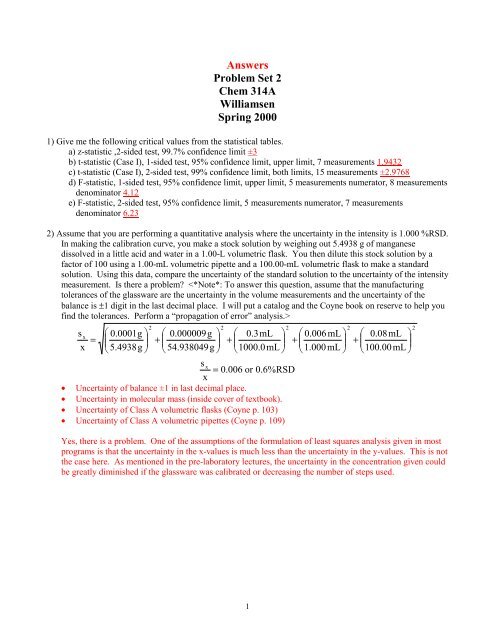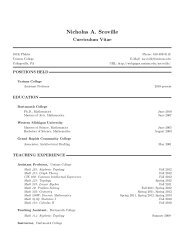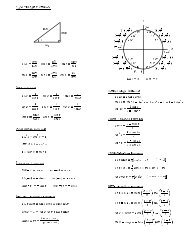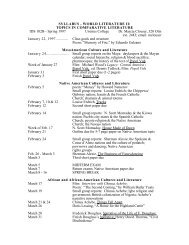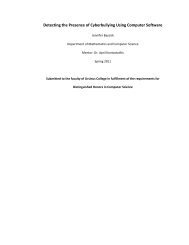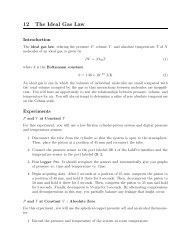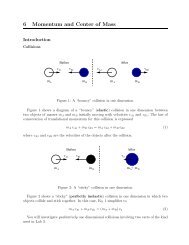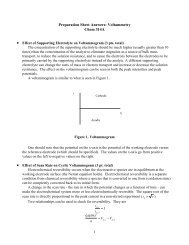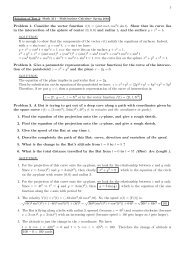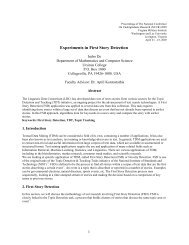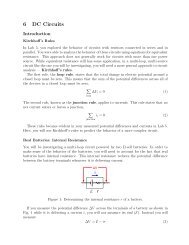Answers Problem Set 2 Chem 314A Williamsen Spring 2000
Answers Problem Set 2 Chem 314A Williamsen Spring 2000
Answers Problem Set 2 Chem 314A Williamsen Spring 2000
Create successful ePaper yourself
Turn your PDF publications into a flip-book with our unique Google optimized e-Paper software.
<strong>Answers</strong><br />
<strong>Problem</strong> <strong>Set</strong> 2<br />
<strong>Chem</strong> <strong>314A</strong><br />
<strong>Williamsen</strong><br />
<strong>Spring</strong> <strong>2000</strong><br />
1) Give me the following critical values from the statistical tables.<br />
a) z-statistic ,2-sided test, 99.7% confidence limit ±3<br />
b) t-statistic (Case I), 1-sided test, 95% confidence limit, upper limit, 7 measurements 1.9432<br />
c) t-statistic (Case I), 2-sided test, 99% confidence limit, both limits, 15 measurements ±2.9768<br />
d) F-statistic, 1-sided test, 95% confidence limit, upper limit, 5 measurements numerator, 8 measurements<br />
denominator 4.12<br />
e) F-statistic, 2-sided test, 95% confidence limit, 5 measurements numerator, 7 measurements<br />
denominator 6.23<br />
2) Assume that you are performing a quantitative analysis where the uncertainty in the intensity is 1.000 %RSD.<br />
In making the calibration curve, you make a stock solution by weighing out 5.4938 g of manganese<br />
dissolved in a little acid and water in a 1.00-L volumetric flask. You then dilute this stock solution by a<br />
factor of 100 using a 1.00-mL volumetric pipette and a 100.00-mL volumetric flask to make a standard<br />
solution. Using this data, compare the uncertainty of the standard solution to the uncertainty of the intensity<br />
measurement. Is there a problem <br />
s<br />
x<br />
=<br />
x<br />
<br />
<br />
<br />
0.0001g<br />
5.4938g<br />
<br />
<br />
<br />
2<br />
<br />
+<br />
<br />
<br />
0.000009g<br />
54.938049g<br />
<br />
<br />
<br />
2<br />
<br />
+<br />
<br />
<br />
s x<br />
=<br />
x<br />
• Uncertainty of balance ±1 in last decimal place.<br />
0.3mL<br />
1000.0mL<br />
<br />
<br />
<br />
0.006 or 0.6%RSD<br />
• Uncertainty in molecular mass (inside cover of textbook).<br />
• Uncertainty of Class A volumetric flasks (Coyne p. 103)<br />
• Uncertainty of Class A volumetric pipettes (Coyne p. 109)<br />
2<br />
0.006 mL <br />
+<br />
<br />
1.000mL<br />
<br />
<br />
2<br />
<br />
+<br />
<br />
<br />
0.08mL<br />
100.00mL<br />
Yes, there is a problem. One of the assumptions of the formulation of least squares analysis given in most<br />
programs is that the uncertainty in the x-values is much less than the uncertainty in the y-values. This is not<br />
the case here. As mentioned in the pre-laboratory lectures, the uncertainty in the concentration given could<br />
be greatly diminished if the glassware was calibrated or decreasing the number of steps used.<br />
<br />
<br />
<br />
2<br />
1
3) You are performing a quantitative analysis to determine the concentration of Ca in a sample of seawater.<br />
After determining that the other constituents of the seawater will not interfere with the analysis, you make a<br />
calibration curve from intensity data measured while analyzing samples of known Ca concentration. Then you<br />
analyze your sea water sample. After analyzing the results, you determine that the uncertainty about your<br />
unknown concentration determination is too large.<br />
a) State 4 ways in which you could decrease the uncertainty.<br />
• Measure at more standard concentrations<br />
• Make more measurements of the unknown<br />
2<br />
• Improve your technique to reduce s yx<br />
• Have more standard concentrations near the<br />
ends of the calibration curve<br />
• Pick your standard concentrations so that the<br />
unknown will be near the center of the<br />
calibration line<br />
b) Write the important equation(s) that helped you in determining how you can decrease the uncertainty and<br />
show how your changes affect the values in this equation.<br />
<br />
1−a<br />
t <br />
1<br />
n− 2<br />
N + 1 n + (y s<br />
− y ) 2<br />
b 2<br />
x i<br />
− x<br />
<br />
i<br />
( ) 2<br />
<br />
<br />
<br />
2<br />
s yx 2<br />
s<br />
b 2 yx<br />
=<br />
( y i<br />
− y ˆ i<br />
) 2<br />
i<br />
n − 2<br />
• Measuring more standard concentrations (n) will decrease 1 n , will decrease t, and will decrease s 2<br />
yx<br />
( )<br />
• More standard concentrations near the edges of the calibration curve will increase the x i<br />
− x<br />
• More measurements of the unknown will decrease 1 N<br />
• Picking standard concentrations so the unknown will fall near the center of the calibration curve will<br />
decrease y s<br />
− y<br />
( ) 2<br />
2<br />
• Improve your technique to reduce s yx<br />
to reduce<br />
( )<br />
y i<br />
− ˆ y i<br />
4) One area of consideration when performing a hypothesis test is the setting of α- and β-error.<br />
a) What are α- and β-errors Describe this in words and in pictures.<br />
α-error is the chance of rejecting the null hypothesis when the null hypothesis is true, and β-error is the<br />
chance of accepting the null hypothesis when the research hypothesis is true.<br />
Values:<br />
accept null<br />
hypothesis<br />
<br />
i<br />
Values: accept<br />
research<br />
hypothesis<br />
2<br />
<br />
i<br />
2<br />
β<br />
α<br />
2
) How is the β-error set<br />
The β-error is indirectly set by the α-error (which is directly set) and by the number of measurements.<br />
5) When determining the correct t-value to use in calculating the confidence limit of a number of measurements,<br />
only one degree of freedom is lost, while when performing the calculation to determine the correct t-value to<br />
use in calculating the confidence limit about a regression line, two degrees of freedom are lost. Why<br />
One degree of freedom is lost when calculating the confidence limit about a measurement because the<br />
sample mean is calculated. Two degrees of freedom are lost about the regression line are lost because two<br />
statistics, the y-intercept and the slope, are calculated.<br />
6) Most of the data sets that you will acquire during your lifetime will only be a sample of a population.<br />
Although practical reasons often limit you to small number of points due to time constraints, statistical<br />
theory tells us that under most conditions it is better to acquire more points. State why we would want to<br />
obtain more data in each of the following cases. Use diagrams or expressions to support your reasoning, if<br />
applicable.<br />
a) Your data has a Poisson distribution, but you would like to analyze your data by performing an F-test.<br />
One of the assumptions of the F-statistic is that the data is obtained from a normal distribution. The F-<br />
statistic is not very robust so even data that is obtained from an “almost normal” distribution is suspect.<br />
Although the data on which you wish to work follows the Poisson distribution, you can still use the<br />
“normal distribution” statistics if the sample is large enough (n>30). The central limit theorem tells us<br />
that no matter what the underlying distribution is, the data becomes more normally distributed as more<br />
data is taken.<br />
b) You are performing a hypothesis test and wish to reduce both the α- and β-error simultaneously.<br />
One part of a hypothesis test is to set the α-level, which also sets the β-level. Without taking more data,<br />
decreasing the β -level will increase the α -level and vice-versa. Taking more data will narrow the<br />
distributions (decrease uncertainty) and therefore limit the values within the distribution that are outside<br />
the set threshold(s).<br />
c) You are performing a hypothesis test using the t-statistic and wish to accept the research hypothesis at<br />
the 95% confidence limit.<br />
The research hypothesis is accepted if the calculated t-value is larger than the absolute value of the<br />
critical t-value. As the sample size increases, the critical t-value decreases. Also as more data is<br />
acquired, the calculated t-value increases as t is proportional to n . Therefore, if there really is a bias,<br />
the calculated t-value will eventually become larger than the critical t-value.<br />
d) You can calculate the sample mean and wish to decrease the confidence limit of your estimate of the<br />
population mean.<br />
ts<br />
The confidence limit of an estimate of the mean is given as . Therefore, as the number of data<br />
n<br />
points (n) increases, the confidence limits and uncertainty decrease.<br />
7) Statistics for Analytical <strong>Chem</strong>ists p. 80 <strong>Problem</strong> 6.<br />
Answer p. 179.<br />
Question: Is this spectroscopic method accurate<br />
Statistic: t-test (Case I)<br />
Level of significance: 95% confidence limit<br />
Hypotheses (General form): H 0 : µ certified = x spectroscopic<br />
H 1 : µ certified ≠ x spectroscopic<br />
3
Experimental t-values:<br />
Sample<br />
Number t-statistic<br />
1 1.54<br />
2 1.60<br />
3 1.18<br />
4 1.60<br />
Critical Value: t(0.95,7)=±2.36<br />
Decision: Because all of the experimental t-statistics are within the critical limits, accept the null<br />
hypothesis. The spectroscopically obtained values differ from the calibrated values by random variation<br />
at the 95% confidence limit with 7 degrees of freedom. Therefore, the spectroscopic method appears to<br />
accurately determine the value.<br />
8) Statistics for Analytical <strong>Chem</strong>ists p. 80 <strong>Problem</strong> 7.<br />
Answer Chapter 3 p. 179. You would give the complete hypothesis test, I will only give you the<br />
important values.<br />
a) F-test (compare variances)<br />
Experimental F: F=112 Critical value: F(0.95,7,7)=3.787 The decision would be that the longer boiling<br />
point's variation is greater than can be explained by random variation at the 95% confidence limit with 8<br />
measurements.<br />
b) t-test (Case II) (compare means)<br />
Experimental t: t=1.8 Critical value: t(0.95,14) )=±2.14
11) Mermet et al. Analytical <strong>Chem</strong>istry p 733 <strong>Problem</strong> 19.<br />
Hypotheses: H 0 : s A =s B<br />
H 1 : s A ≠s B<br />
F=6.13 Because the calculated F-value is larger than the critical F-value, reject the null hypothesis.<br />
The only statement that is true is that the hypothesis of method A being less precise than method B can not<br />
be rejected. You did not directly test this hypothesis (that would be a 1-sided test), but because the<br />
variances were found to be different, this hypothesis is not ruled out.<br />
12) Mermet et al. Analytical <strong>Chem</strong>istry p 733 <strong>Problem</strong> 20.<br />
Bullet 1:<br />
Test: F-test<br />
Level of significance: 95% confidence limit<br />
Hypotheses:<br />
H 0 : s field ≤s laboratory<br />
H 1 : s field >s laboratory<br />
Experiment F: 14.0<br />
Decision: Because the experimental F-value is greater than the critical value, reject the null hypothesis.<br />
Therefore at the 95% confidence level with 7 degrees of freedom for each measurement, the precision of<br />
the laboratory method is significantly greater than the field method.<br />
Bullet 2:<br />
Test: t-test (Case II)<br />
Level of significance: 95% confidence limit<br />
Hypotheses: H 0 : 5.50=4.80<br />
H 1 : 5.50≠4.80<br />
Experimental t: 4.25<br />
Critical t: t(0.95,14)=2.145<br />
Decision: Because the experimental t-value is greater than the critical t-value, reject the null hypothesis.<br />
Therefore at the 95% level of significance with 14 degrees of freedom, the means of the two<br />
methods do differ significantly.<br />
Last Revision: 4 March <strong>2000</strong> EJW<br />
5


